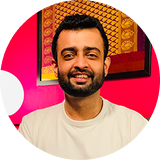Journals
Transitioning Roles: Industrial Designer to a UI/UX Designer

My core studies come from the field of Industrial design and more accurately from Product design. As a student I remember very clearly that from Day 1 they used to tell us that: “All design is human-centered and solves a problem. If it’s not human-centered and doesn’t solve a problem, then it’s not design and if it’s not design, it’s art”. Throughout the product design studio courses, we were taught how to explore the relationship between people and objects. We analyzed physical qualities, ergonomics, semantics and function.
I graduated from college with a bachelor’s degree in Product Design. At the time, the scene was rough — not much was happening for any industrial designers, let alone graduates. I took a risk and decided to drop industrial design and try working purely as a UI/UX Designer… Fast forward, I’m now working as a UI designer at Lights Out Studios based in Bengaluru.
Why UI/UX? In my final year of college, I completed a couple of courses which used a human-centered design approach. The projects had a large digital component to them and I have always been fascinated with the intersection between business, humans, and technology, which made UI/UX design very appealing.
Earlier I mentioned dropping industrial design… well that’s what I thought I was doing at the time. Since my career pivot, I’ve noticed many interesting parallels between industrial design and product design. Although the outputs are different, it’s amazing to see how many of the design principles and processes are the same, even some of the tools I’ve carried between industries.
There is a number of overlaps I’ve found between both industries.
Research: In both fields we utilize research methodologies like ethnography, storyboarding, user journey mapping, interviewing, surveying, diary studies, observation etc. We have the same research goal; to learn as much about the end user as position.
Ideation: In both fields we generate, develop, and communicate new ideas. Ideation in both disciplines comprises all stages of a thought cycle, from innovation, to development, to actualization. As such, it is an essential part of the design process. I’ve found in both fields that I have ideated through journey maps, sketches, mood boards, prototypes and similar stuff.
Evaluation & validation: In both fields we evaluate and validate customers (do we have a customer?) problems (does this problem actually exist?), concepts (does this solve the problem?), experiences (does this solution present any problems?) and technical validation (code / manufacturing). In both fields this can be done with user interviews, observation, sketching, prototyping and testing.
The end goal: In both fields the end goal is the exact same, we want to create a great product that satisfies our users needs. The medium we use to achieve this may be different, but the goal remains the same.
UI/UX lies between aesthetics and science and requires both extremely acute analytical thinking and creativity. It didn’t matter when I changed my tools from a 3D modeling software and a rendering machine to a photo editing or a vector software. What mattered was that I always carried in mind that design must have the user placed in the center of the process with the purpose of solving a specific problem. This is what design is about.


